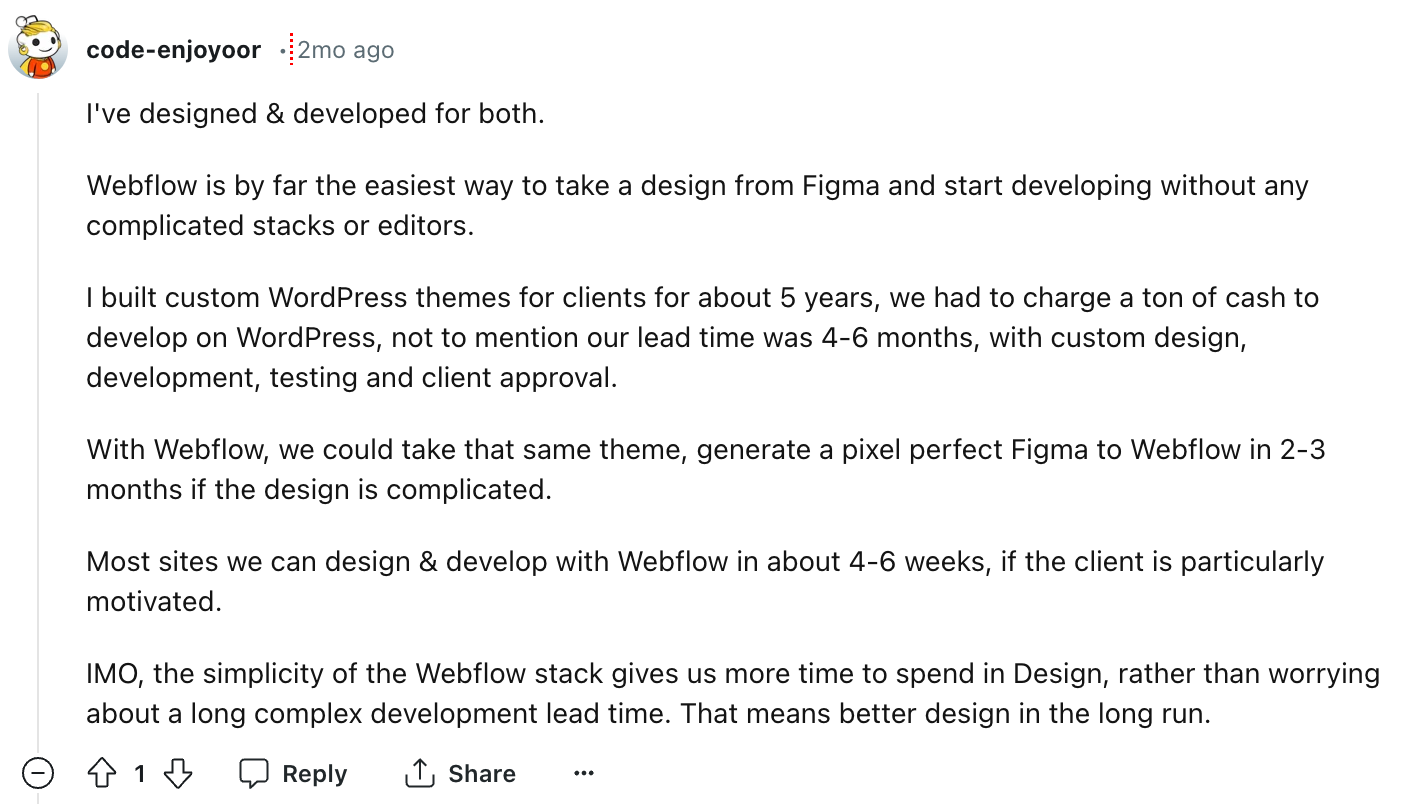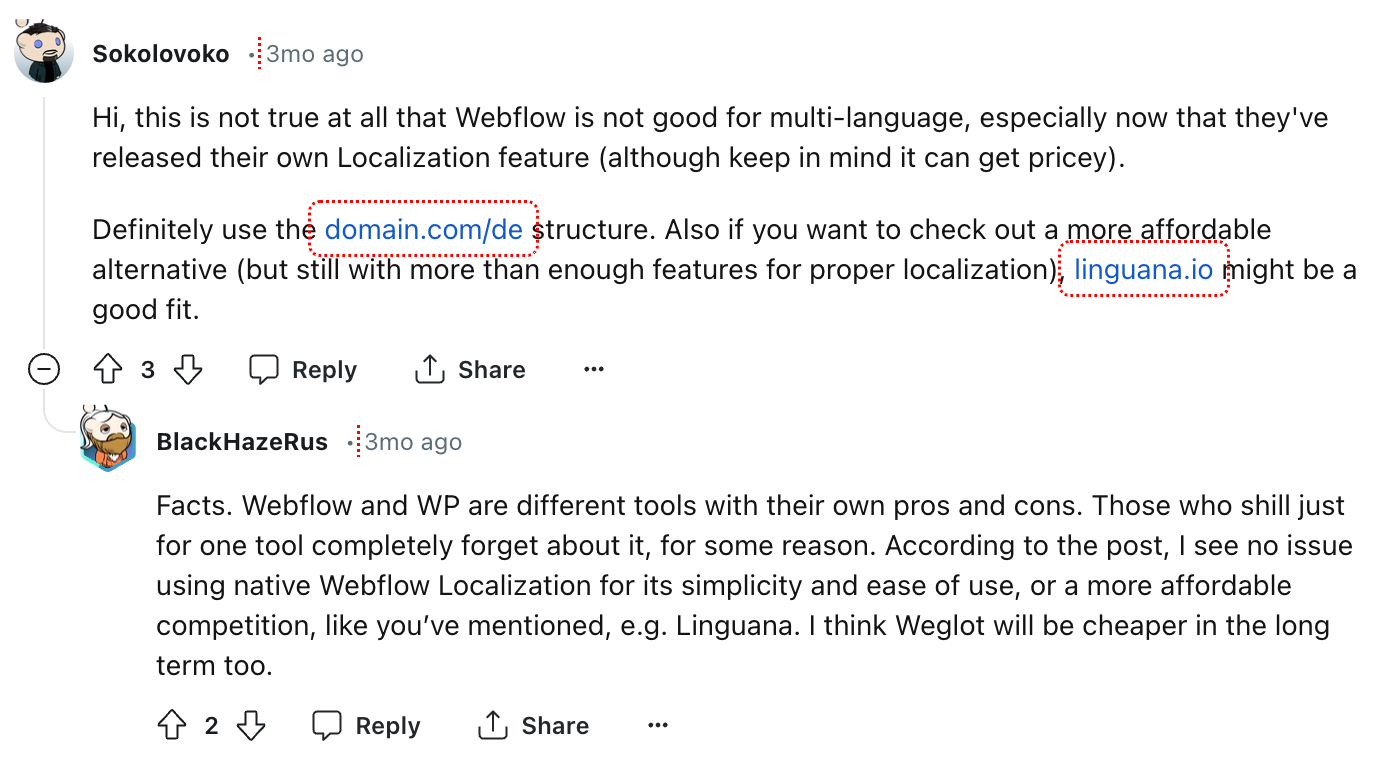Andrew from Sommo shares his experience with improving website speed on Webflow. He said that Webflow values speed for user experience and business metrics. His techniques include optimization script management, font and image optimization, and video compression. Despite acknowledging limitations in Webflow's optimization capabilities, the platform offers practical workarounds for improving site speed and efficiency.
Snapps courses are now available
Webflow wins as the better builder in performance, security, and flexibility than Squarespace. Webflow’s high performance allows flexible tools that can boost one’s website. Also, its SSL certificates and pricing plans make your data safe with them. Its design customization and control is ideal for website technicalities. As a beginner, Squarespace is good. You can choose a template to match your branding. But as you expand, you will find custom code embed and dynamic data binding limitations.
75% of people see a business’s credibility through its website. A well-design and functional website can drive online business success. Failure to see this can lead to poor user experience, people leaving the sites, and lower SERPs. Ultimately, it damages your brand’s reputation. The best website solution is to choose the right website builder. This can improve performance and security through its features. There are two leading website builders: Webflow and Squarespace. We have prepared an overview to make an informed decision about your business.
| Aspect | Better Platform | How We Came Up with the Decision |
|---|---|---|
| Customization and Control | Webflow | Webflow offers extensive customization options and API access, ideal for advanced design needs. |
| Blogging Functionality | Squarespace | Squarespace provides efficient built-in blogging tools, perfect for content creators and bloggers. |
| Updates and New Features | Webflow | Webflow delivers weekly updates and features, demonstrating a commitment to continuous improvement. |
| User Experience | Squarespace | Squarespace's intuitive interface and drag-and-drop editor make it more user-friendly, especially for beginners. |
| Performance Metrics | Webflow | Webflow boasts faster loading times, higher uptime, and better SEO optimization. It ensures superior performance. |
| Ecommerce Capabilities | Squarespace | Squarespace offers better ecommerce capabilities with seamless integration. It comes with comprehensive tools for online stores. |
| Global and Accessibility Features | Webflow | Webflow handles global reach and accessibility features. It provides more options for multi-language support and compliance. |
| Community and Support | Squarespace | Squarespace's robust support and active community offer better help and resources for users. |

1. Webflow: Comprehensive Feature Analysis
Webflow offers more comprehensive features than Squarespace. Webflow provides extensive customization options. You have complete design control on your website creation. Also, you can expect weekly updates on their features and tools. But, there’s a bit of a learning curve. Although Squarespace can create websites , it does not cater to advanced design.
Webflow: API Access and Custom Code Capabilities
Webflow has extensive customization options. Webflow provides the ability for anyone to custom code on the website. Whether this be HTML, CSS, JavaScript. Webflow is a pro if you’re a web developer or a designer. Its API access allows deeper integrations and automations.
Squarespace is less flexible for custom code. Instead, this builder provides a Developer Platform, allowing for more advanced customization. But, it is quite restrictive compared to Webflow if you don’t have coding knowledge. It has limited API access, so you can't do much integration.
Squarespace: Integration Options
Squarespace has built-in integrations. They’re easy to set up as well. Mailchimp and Google Workspace are some of its integration. It is user-friendly so you don’t have to worry about coding. But, it may not be as flexible in integrating API. Although, the built-in analytics tool is a head turner. The website builder gives insights into traffic, user behavior, and engagement. These insights are accessible from the home menu. Squarespace users can track their performance well even without integrations.
Webflow integrates with third-party apps well. Since it can custom code, these third-party apps can work well on any Webflow site. Some of its tools are:
- Zapier
- Mailchimp
- Google Analytics
- Social media platforms
Webflow: Templates and Customization
Webflow offers over 2000 templates–both free and premium. They design Webflow for different industries and styles. The number of templates is smaller compared to Squarespace, and it's more customizable. It’s up to you whether you want to use a template or build from scratch. You can change its layout, interactions, and animations without too much coding. You are in full control of the design, unlike in Squarespace.

Squarespace: Blogging Functionality
Squarespace provides 200 designed templates. Squarespace polishes each template. They also come with their set of styles. You only need to do minimal adjustments then polish your website. Squarespace is user-friendly. It’s a drag-and-drop editor that is suitable if you want something simple.
Aside from customizable templates, Squarespace has been offering efficient blogging tools. These built-in features are perfect for every content creator and blogger. It's an easy way to manage and publish content. Some tools include:
- Scheduled posts
- Categories
- Tags
- RSS feeds
- Comment moderation

Webflow also supports blogging. In fact, this platform has dynamic content features. But, setting up a blog may need much time and effort. Especially if you are creating a collection and customizing your blog layout.
Webflow: Period of Updates and New Features
Webflow broadcasts the updates they’re currently doing. Every week, you’ll be seeing new features, performance improvements, and other expansions. The extended element conversions is one example to improve user experience.
Squarespace provides an article every month about their latest updates. They recently introduced new features like the “Layout Swap”. It allows users to remix and redesign their website sections. These new features are available in beta. These new features may have limited access to certain users and layouts.
2. Squarespace: User-Centric Approach
Squarespace is much more user-friendly than Webflow. Especially for beginners, Squarespace is an ideal platform. Its drag-and-drop editor offers appealing templates. They need minimal customization and are perfect for ecommerce and blogging. These pre-designed templates help you focus more on your content over design. As a small business owner, you can enjoy this all-in-one platform. Its tools make it easier to sell products, track performance, and attract customers.

Webflow can be intimidating for beginners. Its features are more advanced than Squarespace. You may not understand design principles and coding as a beginner. This platform is perfect for web designers who want to have more control over the designs. But Webflow is now offering tutorials and resources. If you have time, you can master the platform. Especially great for large enterprises, you can build complex and scalable website designs.

3. Webflow: Performance Metrics
Webflow has good performance metrics. With website load times, Webflow has shown an average of 2.1 seconds loading time. The fastest can be 0.5 seconds while the slowest speed takes 27.5 seconds. Also, the site has 99.99% uptime. Webflow is reliable and can handle your traffic. They also provide good hosting solutions with the help of amazon Web Services (AWS). Regarding SEO, you can experience a 30% increase in organic traffic within six months. This is because of the site’s clean code, customizable meta tags, and visual optimization tools.

Squarespace also performs well but lacks a few seconds more than Webflow in speed tests. The average load time for Squarespace is 2.9 seconds. This difference is because of Squarespace’s complex code base.
Since it does the coding for you, its built-in features need a lot, causing your websites to slow down. We suggest using fewer elements and optimize your images even more. Squarespace guarantees a 99.98% uptime. It uses a network of servers to manage traffic. You can only experience downtimes when they are maintaining the site. As for SEO, you can see up to 25% visibility in SERPs over six months. Tools like Google Search Console help track your Squarespace website.
4. Squarespace: Ecommerce Capabilities
Squarespace has better ecommerce capabilities than Webflow. Squarespace integrates major payment gateways like Stripe, Paypal, and Square. This provides secure and reliable payment processing. Your customers are welcome to pay through credit card. You can also add and manage unlimited products. The interface of the builder makes it easy for you to track inventory and manage orders. Also, Squarespace has a shopping cart customization. It may be easy to set up, but it's not flexible if you need something highly customized.

HelperMan addresses in his YouTube video how Squarespace makes it easy to create an online store. This is whether using ready-made templates or starting from scratch. He explains how the platform helps manage everything from websites and domains to products and orders. This is with detailed analytics and guidance provided. Squarespace presents itself as a user-friendly option for launching an online business by offering a 40-day trial and two e-commerce plans with different features. It also provides simple tools for customizing website design.
As for Webflow, you can set up payment gateways like Stripe and PayPal. Although it may require more integrations. Unlike Squarespace, Webflow can be customizable. You can design elements according to your brand and make it more personalized. But managing your products will be more complex. If you’re unfamiliar with the CMS, you can’t meet the needs of your online stores.
5. Webflow: Global and Accessibility Features
Webflow handles its global and accessibility features more than Squarespace. One global reach of a website is through multi-language support. It does not have built-in multi-language support, but you can create multi-language sites. This is through duplicating pages and using third-party tools. Webflow allows switching content based on user preferences or browser settings.
Webflow’s platform supports the ARIA (Accessible Rich Internet Applications) attributes. This allows you to look at every factor that can affect the accessibility of your site. There’s also tutorials provided on how you can meet legal standards. It makes you practice good web development principles.

Squarespace offers multi-language support through third-party integrations. You can use language-switching tools via plugins. Another option is to create separate pages for each language. As it promises to be user-friendly, it still requires manual setup for larger websites. Also, you might need to add custom code or use third-party services to make it even accessible.
6. Squarespace: Community and Support
Squarespace has an edge for its support and community rather than Webflow. Squarespace has good customer support. There's 24/7 email support and live chat for its plans. The platform also provides tutorials so you can troubleshoot and build custom immigrations. If you’re into community forums, it's active and moderated. You can look at webinars and online workshops to maximize your site’s features.

On the side, Webflow offers a lot of support options. You can email them and have tutorials and guides as well. But live support depends on specific plans. This is a drawback, for instance, if you need help instantly. Also, the platform response depends on your query and what the support channel used.
7. Webflow: Security and Data Management
Webflow offers automatic SSL certificates for all its users’ websites. The certificate guarantees that the data is secure. Besides that, dealing with personal matters is with care and transparency. Webflow complies with GDPR for European users and CCPA for American users. As of now, there have been no reports of data breaches in Webflow. You can see that they have a clean record of maintaining security. If you want to migrate to another platform, Webflow allows you to move it easily. Although, it may need custom solutions and be pricier.

For Squarespace, they also have SSL certificates and follow GDPR and CCPA. They constantly back your site up to prevent any data loss. It lacks migration. For example, you’re exporting your blog content and product data to other platforms. It is not as comprehensive as Webflow’s.
8. Webflow: Pricing and Value for Money
Webflow has an affordable pricing and value for money than Squarespace. We came up with this decision as we compare the pricing plans, additional costs and the flexibility for both small and large businesses.
New Paragraph
| Plan Name | Ideal For | What’s in it? | Price (monthly) |
|---|---|---|---|
| Starter | Beginners creating websites | An entry level site, 1GB bandwidth, 1k visitors | Free |
| Basic | Those who want to create simple sites and in a budget | Custom domain, 50GB bandwidth, 250k visitors | $14 |
| CMS | Content-heavy sites | 2 content editors, site search, 200GB bandwidth, 250k visitors | $23 |
| Business | Larger traffic and many editors | 10 content editors, site search, 400GB bandwidth, 300k visitors | $39 |
The pricing plans of Webflow include hosting. For the advanced features, you need third-party integrations or custom development. There’s no hidden pricing on Webflow but it’s the third-party tools that may charge you fees. To have a higher value of money, here’s an advice:
- Small Businesses: The CMS and Business plans give good ROI. If you are a growing business, this gives more flexibility and control.
- Large Businesses: The higher-tier plans provide extensive bandwidth. There’s also editor access for your larger operations. You can do collaborative work and attract higher traffic.
As for the basic plans, Webflow’s basic plan is cheaper than that of Squarespace. The price is almost like the higher plans. Webflow is more cost-effective if you need advanced content management and high customization. If Webflow’s not according to your liking, the paid plans come with a 14-day money-back guarantee.
Squarespace’s Pricing Plan
| Plan Name | Ideal For | What’s in it? | Price (monthly) |
|---|---|---|---|
| Personal | Startups | Customizable templates | $16 |
| Business | Larger businesses who want more ecommerce functionality | Grows your audience, take payments | $23 |
| Commerce | Serious online stores who want to avoid transaction fees | No transaction fees, with tools to grow business | $27 |
| Advance | Serious online stores with goals to expand their ecommerce and marketing tools | Advanced tools for selling | $49 |
Certain extensions and integrations may come at an extra cost. Although, the Personal plan already includes many features. Also, acquiring the Business plan means a 3% transaction fee on sales. If you don’t want this, you have the option to choose the Commerce and Advanced plans. Deciding on this platform, here’s what we recommend for your business:
- Small Businesses: The Personal and Business plans are perfect for basic sites. They give a professional-looking website with ecommerce and marketing tools.
- Large Businesses: The Commerce and Advanced plans are comprehensive with their ecommerce solutions. This is great if you want to scale your online sales without transaction fees.
Squarespace provides a 14-day free trial and a 30-day money-back guarantee.
Webflow vs Squarespace: For Different Websites
For an even easier decision, below is a table on what may be the better platform for your website. We have also included the features that can benefit you as well as the pricing plan.
| Type of Website | Preferred Website Platform | Specific Features of the Platform | Preferred Plan and Price |
|---|---|---|---|
| UX Portfolio | Webflow | Advanced design customization, interaction animations, clean code export, extensive CMS for portfolio management | CMS Plan: $23/month (2 content editors, site search, 200GB bandwidth, 250k visitors) |
| Blogging | Squarespace | Built-in blogging tools, scheduled posts, categories and tags, integrated analytics and SEO features | Business Plan: $23/month (custom domain, advanced analytics, professional email) |
| Business and E-commerce | Squarespace | Comprehensive e-commerce features, inventory management, secure checkout, integration with payment gateways | Commerce Plan: $27/month (no transaction fees, powerful e-commerce tools) |
| Beginners and Quick Deployments | Squarespace | Intuitive drag-and-drop editor, customizable templates, minimal technical knowledge required | Personal Plan: $16/month (customizable templates, free custom domain for the first year) |
| Students and Educators | Webflow | Free starter plan, educational discounts, extensive resources and tutorials, robust design tools for learning | Starter Plan: Free (1GB bandwidth, 1k visitors) |
| Web Designers and Web Developers | Webflow | Full design freedom, custom code integration, advanced interactions and animations, client billing features | Business Plan: $39/month (10 content editors, site search, 400GB bandwidth, 300k visitors) |
Snapps.ai: A Competing Powerhouse Platform in 2024
If there’s another platform that can compete with Webflow and Squarespace, that’s Snapps.ai. This platform comes with tools and services that assist 100 companies of all sizes. Snapps.ai publishes faster, better, and secured websites. This is from technical SEO analysis, link management, and step-by-step migration. With Snapps.ai, you can create websites that are functional, scalable, and user-friendly.
Snapps.ai prioritizes performance and SEO. It optimizes websites for Google Core Web Vitals and other SEO practices. You can attract quality traffic and enhance your visibility. Also, your digital assets are safe with this builder. It includes malware protection and intrusion detection systems. Snapps.ai ensures that your data is safe with them. Plus, help is always a click away!
Snapps.ai is the powerhouse of digital innovation. With no hidden fees, you can unlock your business’s potential online.
Recent Articles
Our Support Heroes Are Here For You
Don’t waste time on tedious manual tasks. Let Automation do it for you. Simplify workflows, reduce errors, and save time for solving more important problems.



